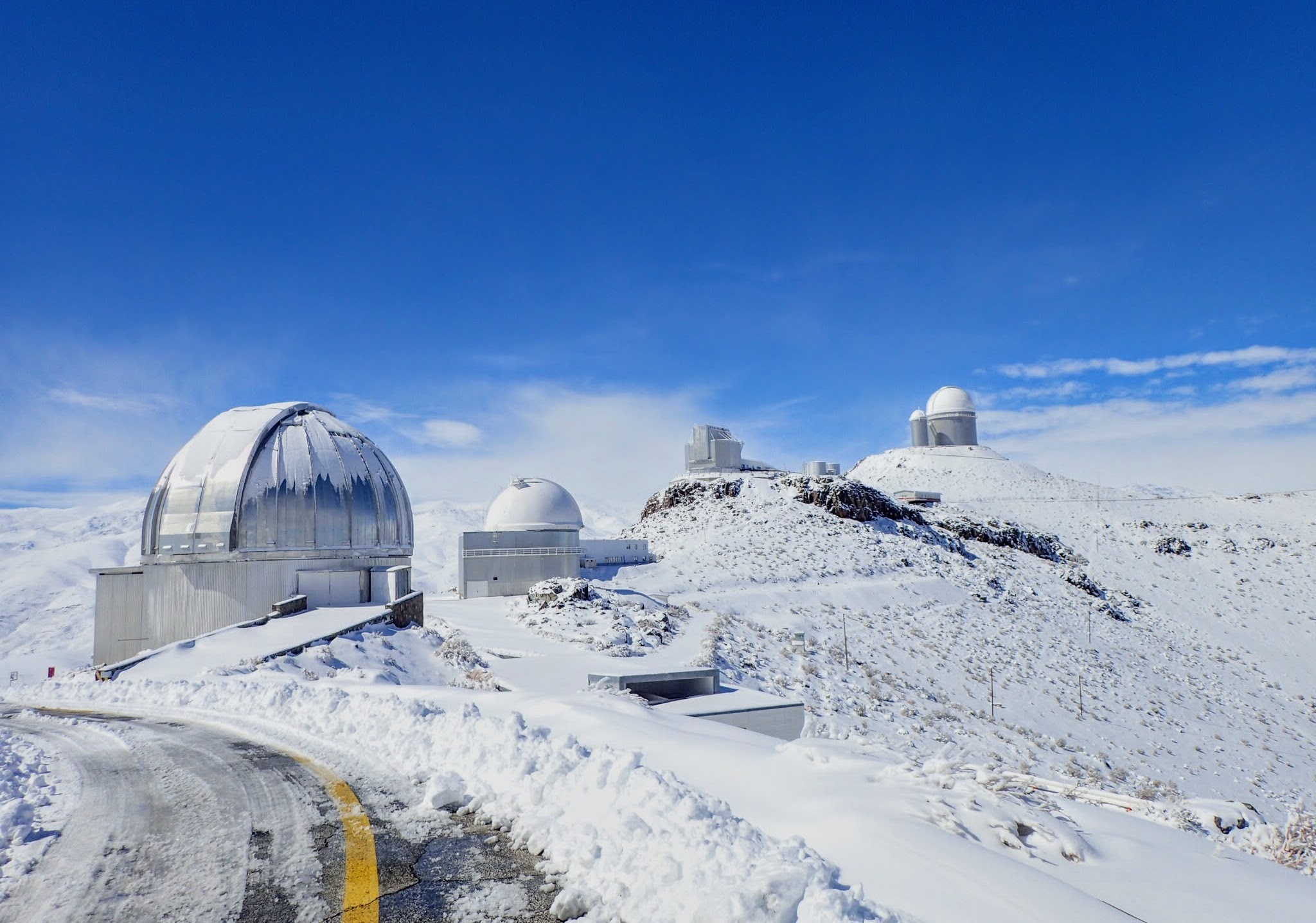Astrophysics Research
I did my PhD in astrophysics at UCLA from 2015 to 2021 and then stayed for an additional year as a postdoctoral scholar. Below is a summary of my research.
Reverberation mapping
Please see my How to Weigh a Supermassive Black Hole page for a more detailed explanation of this work.
We think that most if not all galaxies host supermassive black holes at their centers that are millions to billions of times the mass of the Sun. Observations show that the black holes are tied to their host galaxies' growth, but the physical mechanisms behind the connection are uncertain, and we need precise black hole mass measurements to discern between different scenarios. Outside of the local Universe, we target black holes that are actively accreting material and emitting bright light that can be seen from billions of light years away. Some of these "active galactic nuclei" (AGNs) also show signs of fast-orbiting gas that produces emission lines that are broadened by the Doppler effect. Using a technique called reverberation mapping, we can observe "light echoes" in this so-called broad line region (BLR) and use them to compute the black hole mass.
Since AGNs are so far away, we can't spatially resolve the BLR even with the most powerful telescopes, and the uncertain nature of the BLR introduces additional uncertainty in black hole mass measurements. In my research, I use the code CARAMEL to model the BLR directly. Using this method, we can reduce mass measurement uncertainties while also learning about the BLR structure and kinematics. Below are a few of the reverberation mapping projects I've applied this method to.
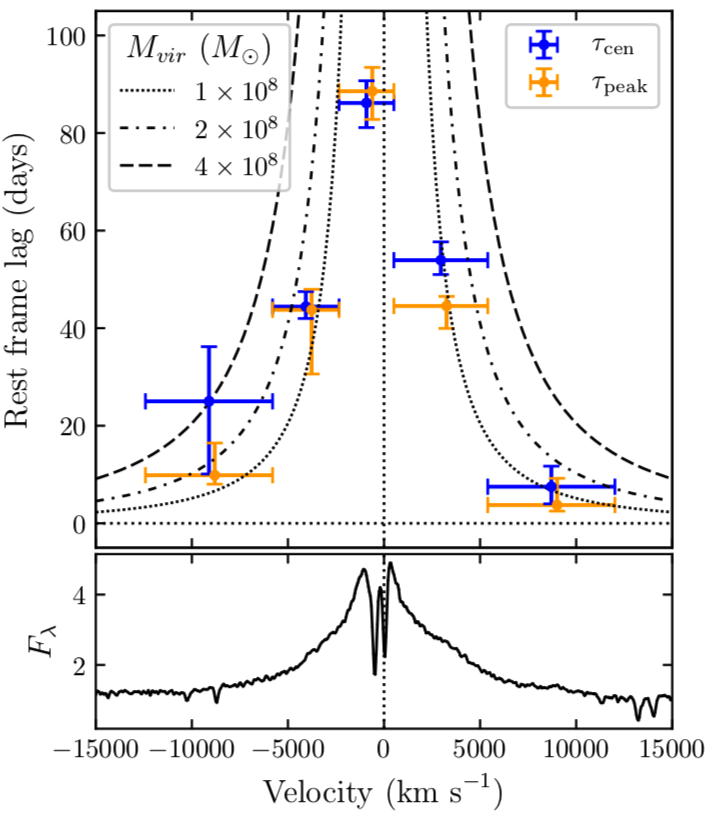
A once in a lifetime opportunity
Reverberation mapping measurements in the distant universe are extraordinarily difficult due to the bright sources required, cosmological time dilation, and a number of other factors. Gravitational lensing, resulting from the chance alignment of an AGN with a foreground massive object, can solve all of these issues simultaneously. In June 2016, we embarked on a multi-year monitoring campaign of the sextuply imaged quasar SDSS J2222+2745, lensed by a foreground galaxy cluster. The lensing time delays and magnifications along with the extreme variability of the quasar offered a unique opportunity to make a black hole mass measurement at redshift $z=2.805$ (~2 billion years after the Big Bang).
In Williams et al. 2021a, I presented the first results of the monitoring campaign. We examined the broad C IV emission line and measured lags (the light echo time) for different parts of the emission line (shown to the left). These measurements tell us that the BLR gas is dominated by near-circular orbital motion. In Williams et al. 2021b, I modeled the C IV-emitting gas around the central black hole, and measured a black hole mass of 200 million solar masses.
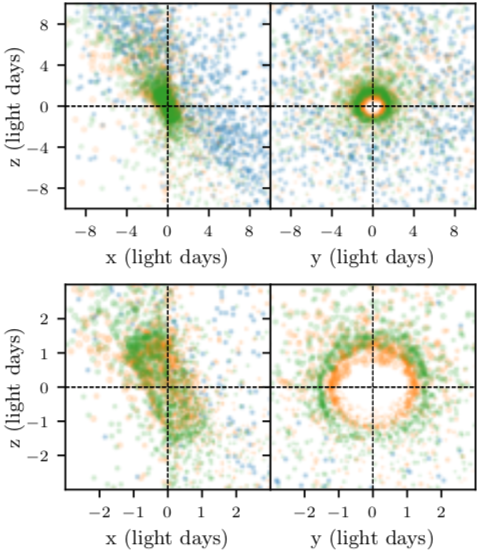
A first measurement of the UV broad line region
The AGN Space Telescope and Optical Reverberation Mapping (AGN STORM) campaign monitored NGC 5548 using both ground- and space-based telescopes. The spectra spanned X-ray to optical wavelengths, enabling measurements of both the high- and low-energy BLRs. In Williams et al. 2020, I modeled the data for two UV emission lines, C IV and Ly$\alpha$, and one optical emission line, H$\beta$. This was the first AGN for which we could model multiple emission lines as well as the first modeling results for the UV-emitting BLR.
To the right are possible geometries of the three BLRs, with edge-on views in the left-hand panels and face-on views in the right-hand panels. C IV is shown in orange, Ly$\alpha$ in green, and H$\beta$ in blue. We found that all three BLRs can be described by inclined thick disks, but the C IV and Ly$\alpha$ BLRs are more concentrated in shell-like structures. We also found radial stratification of the BLR, with the UV BLRs occupying smaller radii than the H$\beta$ BLR. This has been observed using emission line lag measurements, but had never before been demonstrated using 3D models.
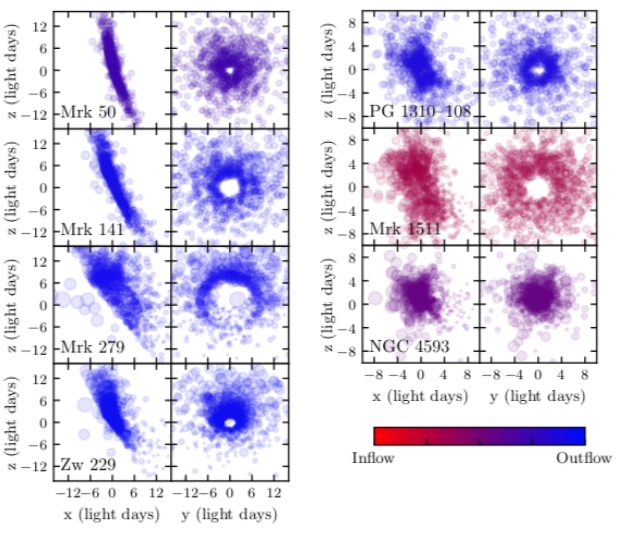
Doubling the sample of BLR models
The Lick AGN Monitoring Project (LAMP) is a series of reverberation mapping campaigns conducted at Lick Observatory targeting the broad H$\beta$ emission line. In Williams et al. 2018b, I modeled the data for seven AGNs in the LAMP 2011 sample. At the time, only eight AGNs had been analyzed using the modeling approach, so this nearly doubled the sample of modeled BLRs. The geometries were consistent with previous modeling results, demonstrating some consistency across all BLRs, but we found more variety in gas kinematics than had previously been observed.
Using the new sample, I explored possible correlations between various observable AGN properties and BLR model parameters. Since not all AGNs have data good enough for BLR modeling, the existence of a correlation would provide a quick way to infer BLR properties and could improve virtually all black hole mass measurements. While we found some evidence of correlations, solidifying them will require increasing the modeled sample further.
Lensed quasar hunting
The phenomenon of gravitational lensing occurs when a massive object falls along our line of sight to a more distant light source. Since gravity can deflect light, the image of the distant source gets distorted as it makes its way to our telescopes. A special case of this is strong gravitational lensing which occurs when a bright, distant quasar is lensed by a foreground massive galaxy, resulting in multiple magnified images of the same quasar. Quasars are some of the brightest objects in the universe, and when they are lensed, they serve as phenomenal tools for studying the Universe both in its infancy and in its more recent history. Unfortunately, the unique alignment required makes these objects very rare on the night sky, and current research progress is limited by the small number of known lenses.
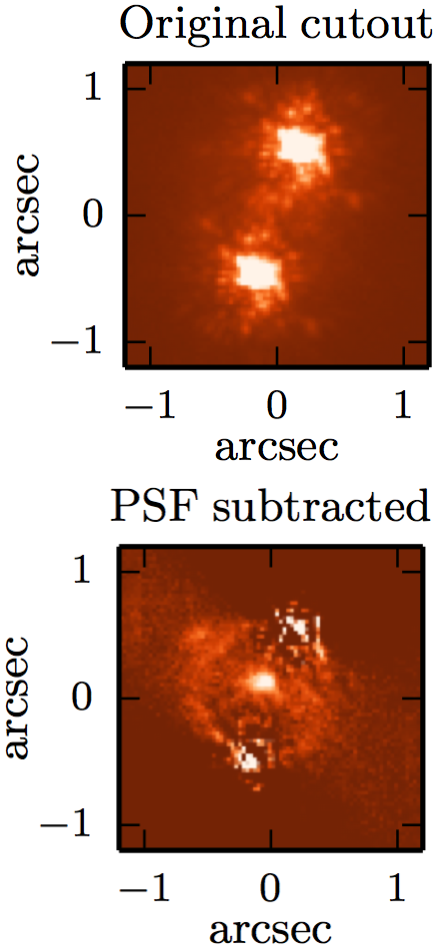
A needle in a haystack
Modern wide-field surveys have imaged large swaths of the night sky and contain images and data for billions of astronomical objects. Hidden in the data could be many undiscovered lenses, but finding them is a classic needle-in-a-haystack problem. In Williams et al. 2017, I used machine learning techniques to sort through data from the Sloan Digital Sky Survey (SDSS), the Wide-field Infrared Survey Explorer (WISE), and the VLT Survey Telescope (VST) ATLAS. Using known lenses as well as simulated lenses, we trained a Gaussian Mixture Model to identify lenses based solely on their photometry (brightness in different colors), and applied the model to the full surveys to produce prioritized lists of lens candidates.
After selecting the most promising candidates, we spent multiple nights with the telescopes at Keck Observatory to obtain high-resolution images and spectra. From the follow-up campaign, we discovered three new lenses, described in Williams et al. 2018a. To the left is one of the lenses—the two bright points in the top panel are images of the same background quasar. Subtracting the bright light of the quasars reveals the dimmer lens galaxy in the center as well as an "Einstein ring."
Publications
Papers on modeling the broad emission line region
- P. R. Williams and T. Treu, "CARAMEL-GAS: A Step toward Fast Empirical Models of the Broad-line-emitting Gas," 2022, ApJ, 935, 128W
- L. Villafaña, P. R. Williams, T. Treu, et al., "The Lick AGN Monitoring Project 2016: Dynamical Modeling of Velocity-Resolved Hβ Lags in Luminous Seyfert Galaxies," 2022, ApJ, 930, 52V
- M. C. Bentz, P. R. Williams, R. Street, et al., "A Detailed View of the Broad Line Region in NGC 3783 from Velocity-Resolved Reverberation Mapping," 2021, ApJ, 920, 112
- P. R. Williams, T. Treu, H. Dahle, et al., "Dynamical Modeling of the C IV Broad Line Region of the z=2.805 Multiply Imaged Quasar SDSS J2222+2745," 2021, ApJ Letters, 951, L9
- P. R. Williams, T. Treu, H. Dahle, et al., "The black hole mass of the z=2.805 multiply imaged quasar SDSS J2222+2745 from velocity-resolved time lags of the C IV emission line," 2021, ApJ, 911, 64
- P. R. Williams, A. Pancoast, T. Treu, et al., "Space Telescope and Optical Reverberation Mapping Project. XII. Broad-Line Region Modeling of NGC 5548," 2020, ApJ, 902, 74
- S. I. Raimundo, M. Vestergaard, M. R. Goad, C. J. Crier, P. R. Williams, et al., "Modelling the AGN broad line region using single-epoch spectra II. Nearby AGNs," 2020, MNRAS, 493, 1227-1248
- S. W. Mangham, C. Knigge, P. R. Williams, et al., "Do Reverberation Mapping Analyses Provide an Accurate Picture of the Broad Line Region?" 2019, MNRAS, 488, 2780-2799
- P. R. Williams, A. Pancoast, T. Treu, et al., "The Lick AGN Monitoring Project 2011: Dynamical Modeling of the Broad-line Region," 2018, ApJ, 866, 75
Papers on lensed quasar searches and follow-up
- A. J. Shajib, E. Molina, A. Agnello, P. R. Williams, et al., "High-resolution imaging follow-up of doubly imaged quasars," 2021, MNRAS, 503, 1557-1567
- P. R. Williams, A. Agnello, T. Treu, et al., "Discovery of three strongly lensed quasars in the Sloan Digital Sky Survey," 2018, MNRAS Letters, 477, L70-L74
- P. R. Williams, A. Agnello, T. Treu, et al., "Population mixtures and searches of lensed and extended quasars across photometric surveys," 2017, MNRAS, 466, 3088-3102
